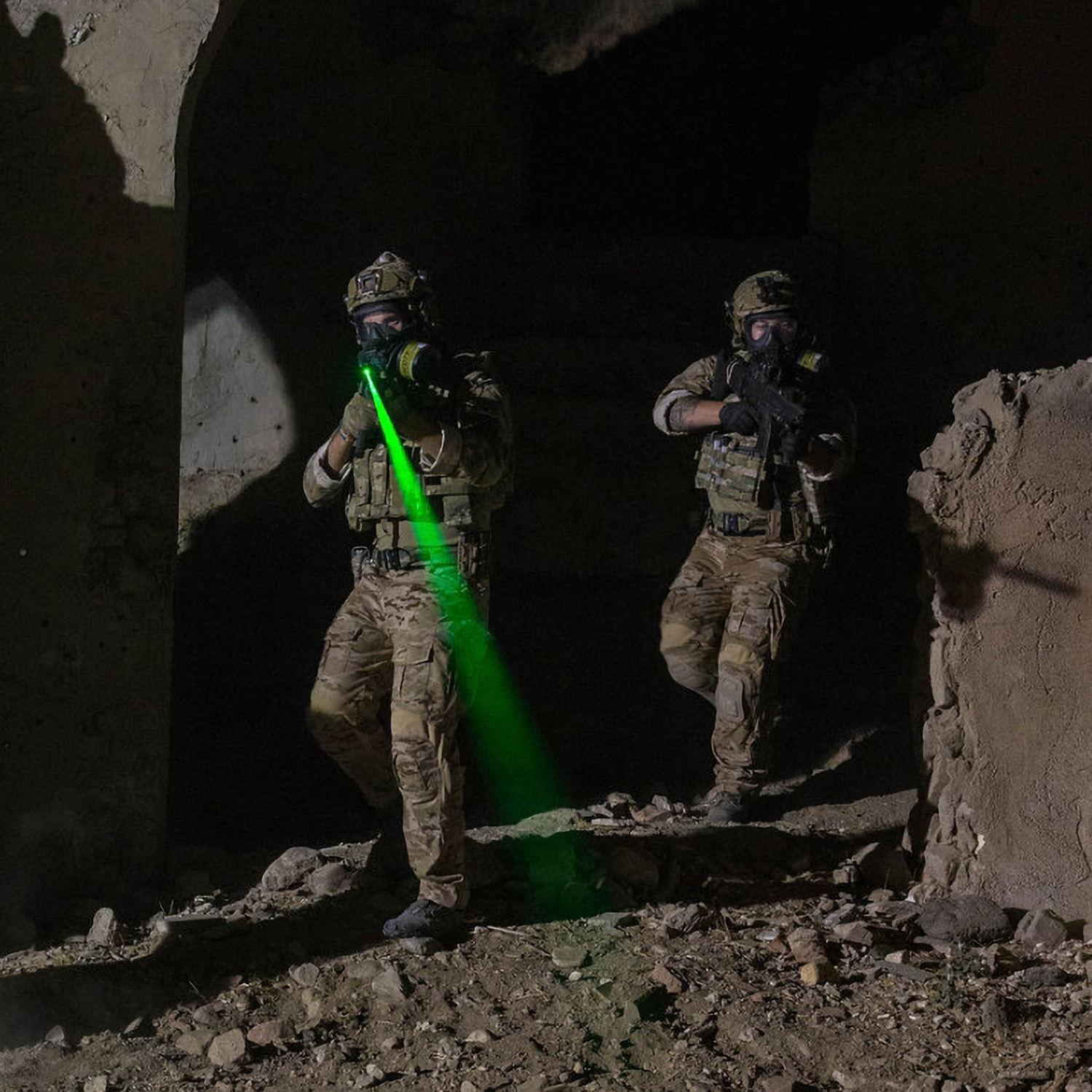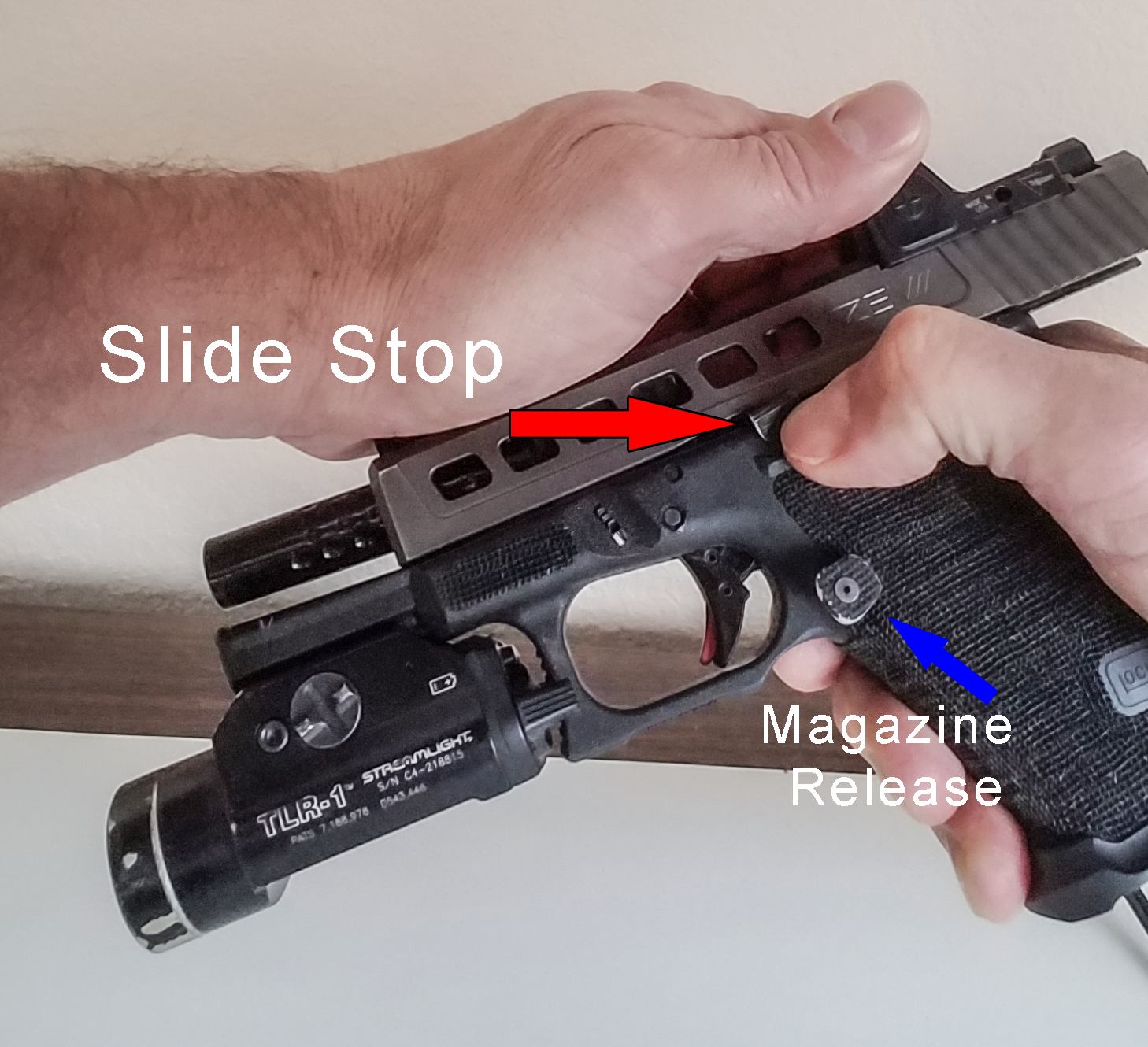The use of tactical lasers is common during training and real-world operations, however it seems few are knowledgeable about the associated safety hazards. Therefore, this post exists to provide important safety information to users of tactical lasers. The information contained is derived from two sources, personal experience and student handouts provided by the Naval Special Warfare Crane, weapons division, located at Crane, Indiana. My personal experience includes teaching formal night vision training courses on the range and real world combat experience.
OSHA recommends training for everyone operating all classes of lasers. The lead instructor/ trainer is responsible for educating and training persons of the associated hazards of lasers. The lead instructor/ trainer will ensure all tactical lasers are operated by informed and educated people. The US Navy recommends that all tactical laser operators take an eye exam before operating a tactical laser for the first time and periodic eye examinations following the initial exam.
Laser damage to the eye may feel similar to sand in the eyes, making them itchy and irritable. The eyes may also feel sunburned, or even hot. Blank spots in vision are also commonly reported. It should be noted that eye glasses and optics will magnify the intensity of the laser by the power of the optic. Most holographic red-dot sights have a magnification power of 1X, so the safe exposure limits listed for a particular class of laser are not accurate. For reasons such as these it is good practice to never consider any laser to be eye-safe.
Laser = Light - Amplification - Stimulated - Emission - Radiation
Normal white light:
- Propagates in all directions

- All wavelengths
- All amplitudes
- All frequencies
Laser light is:
- Mono-chromatic
- very narrow wavelength band

- compared to white light
- very narrow wavelength band
- Coherent
- in phase
- amplitude consistent
- Collimated
The term Maximum Permissible Exposure (MPE) refers to the time length of laser exposure time before the eye will be damaged. The amount of time varies by laser classification. If the calculated amount of time is exceeded eye damage may occur.
You may have noticed that handheld laser pointers that were previously sold at convenience store counters are no longer available. They were marketed as "eye safe" but the truth is, there are no "eye safe" lasers.
Most of the lasers previously sold at convenience store counters were class III or IIIA and have an MPE of 1/4 second. Meaning, if the laser is in direct contact with the eye for more than .25 seconds, eye damage is likely to occur. Today, most of the tactical lasers available are class IIIA and have the same MPE rating.
Magnification. The problem with the "eye-safe" designation is it's impossible to prevent the MPE from being exceeded and it didn't take into account items such as, reading glasses, that may magnify the power of the laser by the power of the lens. Additionally, most red-dot optics magnify the laser by a power of 1X, so a shooter lasing another shooter through the 1X optic has exceeded the MPE of 1/4 second. Therefore, when using lasers in training it is recommended to avoid aiming for the head.
Tactical lasers are currently available in two visible wavelengths green & red, and one invisible wavelength, referred to as Near IR. For example, The Steiner DBAL-A3 is a class IIIB laser with a green laser output of <5mW, 532 nm, the IR laser outputs <7mW, 835 nm. The unit also has a 3rd function which is the IR illuminator. Users should be aware that the illuminator is not an LED type light, but a diffused laser, as such the outputs are <4mW, 835 nm. Also noted, all three types of laser functions available on the A3 unit claim by the manufacturer to have a range of 250 meters. However, this user has engaged steel silhouettes out to 600 meters using the IR functions at night. *Night vision devices required.

There are advantages and disadvantages to red and green lasers. During the day, red lasers are not as visible as green lasers, especially in direct sunlight. However, red has a wider temperature operating range and the batteries last longer on red lasers because they use less energy.
Initially, there were issues with green laser battery life and temperature operating range, which is why red lasers were introduced first. Green lasers have a narrower temperature operating range and lower battery life than red lasers. Green lasers tend to have greater power demands, while red lasers tend to be more energy efficient. However, green lasers are typically brighter, and easier to see across a wider range of lighting conditions. In contrast, red lasers are difficult to see outdoors, even during normally lit conditions.
Infrared lasers cannot be seen with the naked eye, as such they require a Night Optical Device (NOD) to view the laser beam, or infrared illuminator. Because infrared lasers require a night vision device the threat is not likely to realize they are being targeted unless they are also equipped with night vision. *Carefully assess how likely it is that your adversary may have night vision. Because if they do your IR laser is the equivalent of a bright white light but you're assuming you're invisible.
Tactical Laser Safety Protocols
This information is best included in the range safety brief prior to commencing training. The lead instructor/ trainer should know what power lasers are being used by everyone participating in the training.
(1) Lasers are treated like loaded weapons and are not pointed at anyone unless they are known threats or potential threats.
(2) Sweeping with a tactical laser is not acceptable or tolerated.
(3) A tactical laser accidental discharge is to be avoided. This may compromise you're position or even your entire team, not to mention the safety issues.
(4) Lasers should be activated to engage the target and immediately turned off after engaging the target. You'll see in the movies how COOL it looks to have a bunch of lasers crisscrossing as they clear the room. That shit is stupid. Lasers go on to engage a target and immediately go back off, that's how it's done.
(5) Never point a laser at a reflective surface. All metal is potentially reflective, including painted metal. Be aware of the obvious hazards such as mirrors and even windows. *Designating a target through a window with a laser is not reliable. The laser will be diffused to some degree, meaning the beam divergence will separate and the laser will refract (to some degree). The angle of the window will also induce an effect similar to parallax, a term often used in association with magnified optics.
(6) During tactical training weapon mounted lasers are frequently activated longer than the MPE. Inspect the entire range and range area for anything potentially reflective such as unpainted steel, mirrors, and windows. *Painted steel targets made of AR500 or similar steel will become a potential hazard after the paint is worn off due to bullet impact. Re-paint frequently.
Range Inspection for Tactical Laser Use
1. Steel targets engaged in low light/ no light conditions using IR lasers present a significant refraction hazard on the range. Users are protected from refraction hazard as long as their eyes are covered by the night vision. Night vision tubes can be thought of much like a mini-television screen. A laser that refracts directly back at the user will not damage the users eyes as long as both eyes are covered by night vision tubes. Night vision will not amplify the laser, in fact it will protect the users eyes from the laser. However, a refracted laser may impact the eye from the side of the goggles, or effect other personnel on the range who do not have both eyes protected by night vision tubes.
2. Laser Refraction Hazard - a laser may reflect, or refract off nearly any surface. When a laser refracts, the individual refracted beams maintain the same wavelength and intensity as the originally transmitted beam. Paint, tape or cover reflective surfaces.
3. Identify the flanks of the range with red or infrared lighting to visually mark the flanks of the range. Chemical-lights, and other battery-operated lights are good items for marking the boundaries of the range.
4. Inspect the interior of the buildings and structures that will be used for training. Remove or cover all reflective surfaces. Identify uncorrected hazards and their location during the safety brief.
5. Laser illuminators found on devices like the DBAL A3, AN_PEQ-2, AN_PEQ-15 and other devices present a refraction hazard. Night vision will protect shooters from the diffused beam. However, the sides of the NOD may expose the corner of the eye to potential hazards.
It is federal offense to direct lasers at aircraft. Ensure those participating in the training understand this and do not arbitrarily direct lasers into the sky.
Laser Classification
Since the early 1970s lasers have been classified by wavelength and maximum output power into four classes and a few subclasses. The classifications categorize lasers according to their ability to produce damage in exposed people, from class 1 (no hazard during normal use) to class 4 (severe hazard for eyes and skin).
There are two classification systems, the "old system" used before 2002, and the "revised system" phased in after 2002. The revised system is part of the revised IEC 60825 standard. From 2007, the revised system is also incorporated into the US-oriented ANSI Laser Safety Standard (ANSI Z136.1). Since 2007, labeling according to the revised system is accepted by the FDA on laser products imported into the US. The revised system can be distinguished by the 1M, 2M and 3R classes, used only in the revised system.

The 2A and 3A classes are of the old system but still frequently used. Class numbers were designated using Roman numerals (I–IV) in the US under the old system and Arabic numerals (1–4) in the EU. The revised system uses Arabic numerals (1–4) in all jurisdictions.

A radiation hazard exists. Accident data on laser usage have shown that Class I, Class IA, Class II, and Class IIIA lasers are normally not considered hazardous from a radiation standpoint unless illogically used.
Class 1M
LASER RADIATION
DO NOT VIEW DIRECTLY WITH OPTICAL INSTRUMENTS
CLASS 1M LASER PRODUCT
A Class 1M laser is safe for all conditions of use except when passed through magnifying optics such as microscopes and telescopes. Class 1M lasers produce large-diameter beams, or beams that are divergent. The MPE for a Class 1M laser cannot normally be exceeded unless focusing or imaging optics are used to narrow the beam. If the beam is refocused, the hazard of Class 1M lasers may be increased and the product class may be changed. A laser can be classified as Class 1M if the power that can pass through the pupil of the naked eye is less than the AEL for Class 1, but the power that can be collected into the eye by typical magnifying optics (as defined in the standard) is higher than the AEL for Class 1 and lower than the AEL for Class 3B.
Class 2
LASER RADIATION
DO NOT STARE INTO BEAM
CLASS 2 LASER PRODUCT
A Class 2 laser is considered to be safe because the blink reflex (glare aversion response to bright lights) will limit the exposure to no more than 0.25 seconds. It only applies to visible-light lasers (400–700 nm). Class-2 lasers are limited to 1 mW continuous wave, or more if the emission time is less than 0.25 seconds or if the light is not spatially coherent. Intentional suppression of the blink reflex could lead to eye injury. Some laser pointers, tactical lasers and measuring instruments are class 2.
Class 2M
LASER RADIATION
DO NOT STARE INTO BEAM OR VIEW
DIRECTLY WITH OPTICAL INSTRUMENTS
CLASS 2M LASER PRODUCT
A Class 2M laser is safe because of the blink reflex if not viewed through optical instruments. As with class 1M, this applies to laser beams with a large diameter or large divergence, for which the amount of light passing through the pupil cannot exceed the limits for class 2.
Class 3R
LASER RADIATION
AVOID DIRECT EYE EXPOSURE
CLASS 3R LASER PRODUCT
A Class 3R laser is considered safe if handled carefully, with restricted beam viewing. With a class 3R laser, the MPE can be exceeded, but with a low risk of injury. Visible continuous lasers in Class 3R are limited to 5 mW. For other wavelengths and for pulsed lasers, other limits apply.
Class 3B
LASER RADIATION
AVOID EXPOSURE TO BEAM
CLASS 3B LASER PRODUCT
A Class 3B laser is hazardous if the eye is exposed directly, but diffuse reflections such as those from paper or other matte surfaces are not harmful. The AEL for continuous lasers in the wavelength range from 315 nm to far infrared is 0.5 W. For pulsed lasers between 400 and 700 nm, the limit is 30 mJ. Other limits apply to other wavelengths and to ultrashort pulsed lasers. Protective eyewear is typically required where direct viewing of a class 3B laser beam may occur. Class-3B lasers must be equipped with a key switch and a safety interlock. Class 3B lasers are used inside CD and DVD writers, although the writer unit itself is class 1 because the laser light cannot leave the unit.
Class 4
LASER RADIATION
AVOID EYE OR SKIN EXPOSURE TO
DIRECT OR SCATTERED RADIATION
CLASS 4 LASER PRODUCT
Class 4 is the highest and most dangerous class of laser, including all lasers that exceed the Class 3B AEL. By definition, a class 4 laser can burn the skin, or cause devastating and permanent eye damage, as a result of direct, diffuse or indirect beam viewing. These lasers may ignite combustible materials, and thus may represent a fire risk. These hazards may also apply to indirect or non-specular reflections of the beam, even from apparently matte surfaces. Extreme caution must be taken to control the beam path. Most industrial, scientific, military, and medical lasers are in this category.



1 comment
Leave a comment
This site is protected by reCAPTCHA and the Google Privacy Policy and Terms of Service apply.